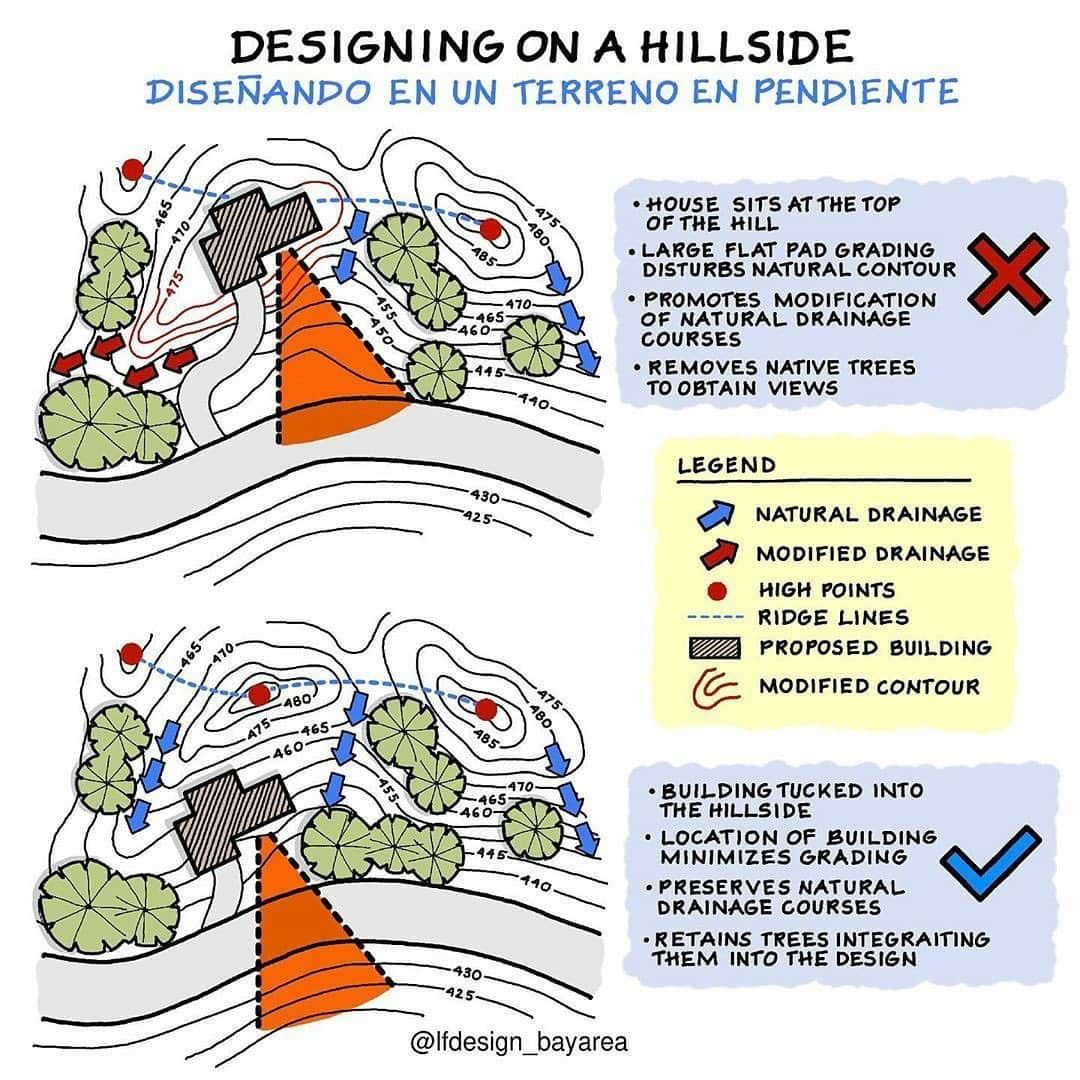🌱 “Experts stress that respecting natural contours and drainage systems is the key to safe, eco-friendly housing on sloped terrains.”
Introduction
As urban populations grow and land becomes scarce, hillside construction is becoming more common worldwide. From the hills of California to the slopes of Latin America and Asia, homeowners are drawn to elevated sites for their spectacular views and fresh air. Yet, many of these homes face a hidden danger: poor hillside design that disrupts natural drainage and destabilizes the terrain.
A recent study illustrated in the image above shows two contrasting approaches. The first, a poorly placed building at the hilltop, requires flattening natural slopes, cutting down trees, and altering water flow — creating long-term risks of erosion and flooding. The second, a home nestled within the hillside, works with the land rather than against it, preserving drainage paths and native vegetation.
The difference between these two approaches is not only about aesthetics — it is about safety, sustainability, and resilience against climate change.
The Wrong Approach: Flattening the Hilltop
Building a house at the very top of a hill may sound ideal — great views, privacy, and prestige. However, to achieve this, builders often create a large flat pad by cutting into the slope or filling soil to create an artificial platform.
According to landscape architect Laura Mendoza, this approach comes at a high cost:
- Disturbed natural contours: Flattening alters the slope, making the soil unstable and prone to landslides.
- Modified drainage: Natural rainwater paths are blocked, forcing water to divert around the building, often causing erosion elsewhere.
- Tree removal: Native trees, which hold soil together and regulate water flow, are often cut to make space for views or access.
“Every time you erase a natural ridge or drainage channel, you’re creating a new problem,” Mendoza explains. “The hill has its own system of balance, and forcing it to change usually backfires.”
The Right Approach: Working with the Slope
Instead of dominating the hillside, modern sustainable design encourages tucking the house into the slope. This method respects the natural contour of the land, minimizing excavation and grading.
The benefits are significant:
- Natural Drainage Preserved – Water continues to flow downhill naturally, reducing erosion risks.
- Less Grading, More Stability – Smaller cuts into the land mean soil strength is maintained.
- Tree Integration – Native vegetation is preserved and even incorporated into landscaping.
- Energy Efficiency – Homes partly embedded into hillsides benefit from natural insulation, staying cooler in summer and warmer in winter.
Architectural designer Jorge Alvarez notes:
“When you design into the hillside, you’re not just protecting the environment — you’re protecting your investment. A home that works with nature is always more resilient than one that fights against it.”
Drainage: The Silent Enemy of Hillside Homes
One of the most critical issues in hillside building is drainage. Rainwater naturally seeks the fastest downhill path. When buildings block or redirect this flow, it creates:
- Erosion gullies beside homes.
- Flooding at the foundation.
- Mudslides in extreme cases.
The diagram shows blue arrows representing natural drainage and red arrows where water is unnaturally redirected. Poor planning turns these red arrows into destructive forces.
Civil engineer Anita Kumar warns:
“Water will always find a way. If you don’t give it a safe passage, it will carve one itself — usually through your garden, driveway, or worse, your foundation.”
Real-Life Consequences
The dangers of poor hillside design are not hypothetical. In many hillside communities:
- Families face annual landslides during rainy seasons.
- Roads collapse because of uncontrolled runoff.
- Entire neighborhoods require costly retaining walls to prevent soil collapse.
For example, in 2021, parts of São Paulo, Brazil, witnessed devastating landslides after heavy rains. Investigations revealed that many homes were built without considering natural drainage lines, leading to soil collapse.
Balancing Human Needs with Nature
The challenge lies in balancing human development with environmental respect. While people need housing, they must also understand that hillsides are living systems — full of trees, water channels, and soil mechanics that cannot be ignored.
Key sustainable strategies include:
- Contour Building: Aligning the house along the slope’s contour rather than cutting across it.
- Split-Level Design: Designing homes with multiple levels that step down the hill, minimizing excavation.
- Permeable Surfaces: Using permeable driveways and gardens to absorb rainwater.
- Tree Conservation: Retaining native trees that act as natural stabilizers.
Policy and Education
Governments also play a vital role. Urban planning authorities must:
- Ban construction on ridge lines where grading is excessive.
- Enforce drainage studies before building permits are issued.
- Educate homeowners and builders about contour-sensitive design.
In progressive regions, building codes now require hillside construction to undergo geotechnical assessments, ensuring that natural water flows are mapped and preserved.
The Future of Hillside Living
As climate change intensifies rainfall and storm events, hillside settlements face greater risks. Sustainable design isn’t just environmentally friendly — it is a necessity for survival.
Communities that adopt hillside-sensitive planning will avoid costly disasters, while those who ignore it may pay the price in erosion, flooding, and structural failure.
Conclusion
The image says it all: build with the hill, not against it.
A house perched arrogantly at the top of a flattened slope might look impressive for a few years, but over time, nature will reclaim its course — often violently. In contrast, a house gently tucked into the hillside becomes part of the landscape, safe and sustainable for generations.
In hillside design, respecting nature is not a limitation — it’s the ultimate blueprint for success.
